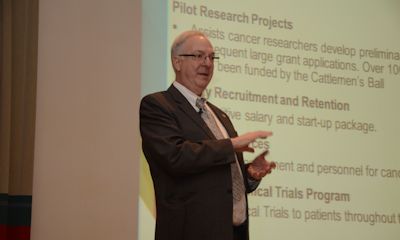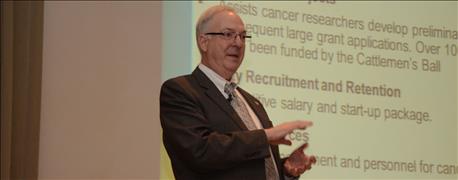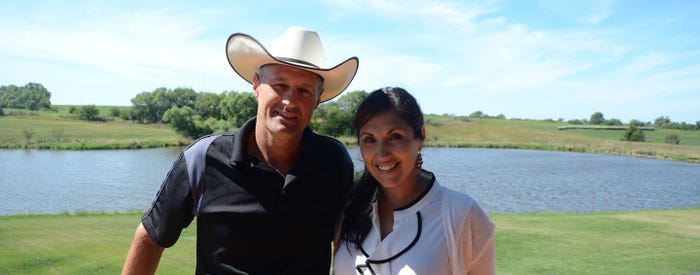
Cancer is something that affects everyone. Just this year, 1.6 million people in the U.S. were diagnosed with cancer. It's the leading cause of death for people under 85 years of age, and half of Americans will be diagnosed in their lifetime. It's something that ranchers, farmers, and other community members from across Nebraska come together to raise funds to fight each year at the Cattlemen's Ball of Nebraska.

FUNDING IS CRITICAL: Funds from the Cattlemen's Ball typically go toward assisting cancer researchers in developing preliminary results for subsequent large grant applications. "These startup funds have been critical, and the Cattlemen's Ball has been incredible to be able to offer these opportunities to researchers and ultimately our patients," says Kenneth Cowan.
"Every single person who attends these balls has been touched by cancer," Dr. Kenneth Cowan, director of the Fred and Pamela Buffett Cancer Center in Omaha, told members of the planning committees of the Cattlemen's Ball during a tour of the center in November. "It's a lot of work. It will be transformative for your community."
A lot of work, but the results are long-lasting, Cowan adds. Ninety percent of the funds raised at the ball go toward funding research at the Buffett Cancer Center, while 10% go toward local communities. That partnership has helped recruit over 100 new faculty members on all of the Buffett Cancer Center's campuses.
The newest addition to the Buffett Cancer Center will bring the new ten-story Walter and Suzanne Scott Cancer Research Tower and CL Werner Cancer Hospital all under one roof. A "topping off" ceremony was held on August 11, 2015, and the center plans to start moving patients in in March 2017. The 635,000-square foot facility is expected to bring 1,200 new jobs and an additional $100 million in annual revenue.

FUNDING A CURE: Trevor and Torri Lienemann are hosting the 2016 Cattlemen's Ball of Nebraska on their ranch near Princeton. The purpose of the event is funding cancer research. That's why the slogan this year is "Funding a Cure."
Individualized treatments
The facility is designed to bring all experts and researchers under one roof. "We put this in a place that connects and backs up into our hospital," Cowan says. "Everybody is going in together because we all have one common purpose and that's to help that patient. We want researchers to understand the problems patients actually see. We want health care providers to understand what researchers are seeing."
~~~PAGE_BREAK_HERE~~~
Each individual floor will be dedicated to a disease, and Cowan says with the increased focus on therapies at the genetic level, the goal is individualized treatment.
Over a lifetime, genetic codes get damaged and cells try to repair it. Sometimes, instead of putting the original code, it changes the code instead. This genetic alternation in a normal gene can sometimes cause it to become cancerous. There are about 20,000 to 25,000 protein-coding genes in the human genome – as revealed by the Human Genome Project. Of those 25,000, there are about 1,000 proteins which, if damaged, can become malignant, and the combination of proteins that cause cancer is different for every patient.
However, Cowan notes through research like that done at the Buffett Cancer Center, medical professionals will be able to design treatments that inhibit the specific altered protein – it only affects the cancer cell. This way the treatment is specific to the patient. "Our goal is that eventually everybody comes away with an individualized treatment designed for them," he says. "The future is integrating science with cancer care and coming up with a more precise way, a more individualized way to treat cancer."
Cattlemen's Ball contributions
Where does the Cattlemen's Ball come in? Funds from the ball typically go toward assisting cancer researchers in developing preliminary results for subsequent large grant applications. Through the Cattlemen's Ball, hundreds of pilot projects have gotten off the ground over the years.
At the 2016 Cattlemen's Ball, set for June 3 and 4 at Trevor and Torri Lienemann's ranch, Lienemann Cattle Co., near Princeton, researchers will be present with posters with information on the research funded by the event.
While the event also serves as a way to promote beef as part of a healthy diet and promote the rural lifestyle, the cause for the entire event is funding cancer research. That's why the slogan this year is "Funding a Cure." "It's the Cattlemen's Ball. People know cattle and agriculture are involved, but they don't always know what the cause is about." Torri says. "You don't have to be a cattleman, and you don't have to dress up. It's an extraordinary event, but it's not extravagant."
~~~PAGE_BREAK_HERE~~~
The Buffett Cancer Center is nationally recognized for research in pancreatic and gastro-intestinal cancer and lymphoma, and Cowan notes the ball has played a big role in funding preliminary research for additional federal grants to fund research to help develop a blood test for early detection of pancreatic cancer and develop new therapies for lymphoma. Funding from the Cattlemen's Ball has also helped preliminary research to apply for and receive the Specialized Program of Research Excellence grant to help fund research to test new therapies for pancreatic cancer.
It's funding like this that has helped make great strides in cancer research, Cowan adds. "Without these funds, we can't test out new ideas and be competitive for additional federally funded grants," Cowan says. "If we're going to do cutting edge research, we need funding. These startup funds have been critical, and the Cattlemen's Ball has been incredible to be able to offer these opportunities to researchers and ultimately our patients."
About the Author(s)
You May Also Like






